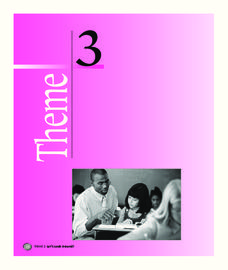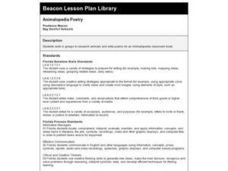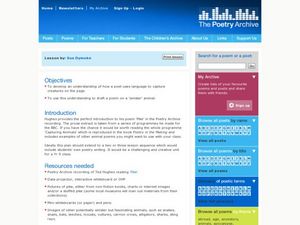Curated OER
Ugly? Says Who?
Students explore biology by writing animal poetry in class. In this animal characteristics lesson, students research the Internet for facts about an "ugly" animal such as a bug or small critter. Students complete worksheets about animal...
Curated OER
Unleashed: Poems by Pets
Students create a poem from the first person perspective of a pet. In this Writing/Poetry instructional activity, students read a short poem from, Unleashed. Students brainstorm what their animal may say. Students write a poem using the...
Curated OER
Kennings: Poetry
Using a list of adjectives, learners answer a riddle. Through this creative presentation, your class can review the use of adjectives and descriptive language. They read a poem full of adjectives and guess which animal is being...
Curated OER
Personification Poems
Personification poems can get students writing and thinking poetically.
Project Oceanography
Fish Shape
A fish's size, fins, and shape can tell us a lot about them! Learners explore fish anatomy to see how species use camouflage, scales, shape, and coloration to survive. The lesson includes advanced vocabulary such as fusiform shape,...
Curated OER
Honoring Our Pets During National Pet Week
Recognize National Pet Week with reading and writing activities to celebrate the animals in your pupils' lives.
Curated OER
Animal and People Habitats
Students examine how animals create a unique space in which they can live. Students read a poem about animals' habitats discuss the habitats. They draw a space of their own and write a poem that describes their habitat.
Curated OER
What's Being Done?
Students explore the concept of animal welfare. In this philanthropy lesson, students examine legislation that supports animals in their state as well as the role of the American Society for the Prevention of Cruelty to Animals....
Curated OER
Animals Matter
Students explore philanthropy. In this character education lesson, students define and give examples of philanthropy. Students listen to the story A Symphony of Whales and describe how the characters helped the whales. Students discuss...
Curated OER
I am a Hero for Animals!
Students explore the humane treatment of animals. In this character development and civic responsibility instructional activity, students define "hero" and brainstorm related attributes. Students complete an action plan using the...
Curated OER
Hattie and the Fox
Who is Hattie? Youngsters explore animal characteristics by reading poems and stories in class. They read the book Hattie and the Fox about a fictitious fox and his drama with the other farm animals. Then they reread the story over...
Houghton Mifflin Harcourt
Let’s Look Around!: Challenge Activities (Theme 3)
Let's Look Around! is the theme of a unit that offers a plethora of challenge activities. Enhance your scholars' learning experiences and reinforce concepts with activities such as writing a book about farm animals, an imaginary place,...
Curated OER
Hyena: an Edward Morgan Poem
Young scholars read, listen to and analyze the poem The Hyena by Edward Morgan. In this poetry techniques lesson, students explore the visual images of animals and their unpleasant traits. Young scholars answer questions about the...
Curated OER
Animalopedia Poetry
Students reseach animals while working in groups. They write poems to be included in a class Animalopedia book.
Curated OER
Animal Farm Chapter One Summary
For this Animal Farm chapter one worksheet, students state the main idea of the chapter. The worksheet asks that the student summary includes title, author, topic, main idea, and quotations. In addition, students paraphrase the chapter...
Shutterfly
Photo Story Lesson Plan
After reading Loree Leedy's There's a Frog in My Throat: 440 Animal Sayings a Little Bird Told Me, kids create and illustrate their own poems that convey the meaning of an idiom. The poems are then transferred into Shutterfly's Photo...
EngageNY
Reading about Freaky Frogs: “The Water-Holding Frog"
Boost reading comprehension skills with a lesson all about freaky frogs. A poem hooks scholars and takes them into a reading of an informational text followed by peer discussions. A three-page worksheet focuses on text features and...
K12 Reader
Make the Same Shape
Make sure your class has a grasp of words that include the long /a/ sound and follow the _a_e pattern. They can read the short poem on this page, which includes many examples of this pattern to practice, and then complete the three...
Lerner Publishing
Teaching Habitats
What makes up a habitat? Use this resource to engage first graders in the exploration of desert, wetland, forest, and ocean habitats. Youngsters classify plants and animals into the four distinct habitats through drawings and cutting and...
Curated OER
Ted Hughes "Pike"
Students analyze how a poet uses language to capture creatures and draft a poem on a 'sinister' animal. In this poetry analysis lesson, students read Ted Hughes' poem 'Pike' and analyze pictures of pike fish. Students use their research...
Curated OER
How Animals Bond
In this animals lesson plan, students students write a description about a pet or animal that they know. They include details that would help someone who has never met their animal feel like they know it already. Artwork about their...
American Museum of Natural History
Being a Conservation Biologist: Eleanor Sterling
Eleanor Sterling responds to 21 questions posed by young learners about the challenges she faces as a woman conservation biologist. She also discusses her research of the aye-aye, an unusual animal that lives in Madagascar.
Curated OER
The Name Game
Young scholars identify animals and their babies. In this animal name instructional activity, students come up with other animals whose babies have the same name. Young scholars use the names of animals and their babies to write poems.
Curated OER
Good Brother, Bad Brother: The Story of Edwin Booth and John Wilkes Booth
Learners examine the lives of Edwin Booth and John Wilkes Booth. They create a "found" poem using the voices of both brothers and perform the poem for the rest of the class.
Other popular searches
- Animal Poems Using Similes
- Farm Animal Poems
- Zoo Animal Poems
- Animal Poems Using Mood
- African Animal Poems
- Writing Animal Poems

























